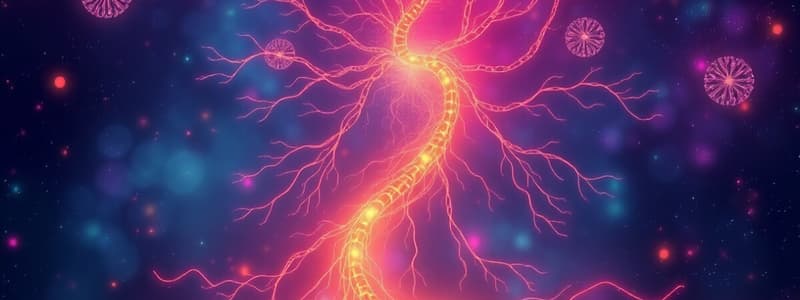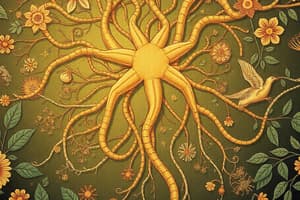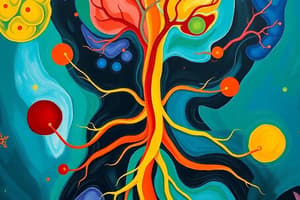Podcast
Questions and Answers
Which hormone is produced by the pancreas to lower blood glucose levels?
Which hormone is produced by the pancreas to lower blood glucose levels?
- Glucagon
- Insulin (correct)
- Testosterone
- Estrogen
Type 2 Diabetes is primarily caused by genetic factors.
Type 2 Diabetes is primarily caused by genetic factors.
False (B)
What is the main function of glucagon in the body?
What is the main function of glucagon in the body?
Raise blood glucose levels
The shedding of the uterine lining occurs during Stage 1 of the menstrual cycle, known as __________.
The shedding of the uterine lining occurs during Stage 1 of the menstrual cycle, known as __________.
Match the hormones with their functions in the menstrual cycle:
Match the hormones with their functions in the menstrual cycle:
What is the primary function of negative feedback loops in homeostasis?
What is the primary function of negative feedback loops in homeostasis?
The nervous system includes the brain and spinal cord only.
The nervous system includes the brain and spinal cord only.
What type of neurons carry signals from receptors to the central nervous system?
What type of neurons carry signals from receptors to the central nervous system?
The __________ system uses hormones to maintain body functions and homeostasis.
The __________ system uses hormones to maintain body functions and homeostasis.
What role do effectors play in the nervous system?
What role do effectors play in the nervous system?
Match the glands with their primary function:
Match the glands with their primary function:
Type 1 Diabetes is caused by the body's resistance to insulin.
Type 1 Diabetes is caused by the body's resistance to insulin.
The nervous system's response to a harmful stimulus bypasses the brain and involves a __________ arc.
The nervous system's response to a harmful stimulus bypasses the brain and involves a __________ arc.
Flashcards
Insulin
Insulin
A hormone produced by the pancreas that lowers blood glucose levels. It's released after a meal to help your body store extra sugar.
Glucagon
Glucagon
A hormone produced by the pancreas that raises blood glucose levels. It's released between meals to keep your blood sugar stable.
Diabetes
Diabetes
A condition where the body doesn't produce or properly use insulin, leading to high blood sugar levels.
Menstrual Cycle
Menstrual Cycle
Signup and view all the flashcards
Estrogen
Estrogen
Signup and view all the flashcards
Homeostasis
Homeostasis
Signup and view all the flashcards
Negative Feedback Loop
Negative Feedback Loop
Signup and view all the flashcards
Stimulus Increase
Stimulus Increase
Signup and view all the flashcards
Stimulus Decrease
Stimulus Decrease
Signup and view all the flashcards
Nervous System
Nervous System
Signup and view all the flashcards
Receptors
Receptors
Signup and view all the flashcards
Central Nervous System (CNS)
Central Nervous System (CNS)
Signup and view all the flashcards
Reflex Arc
Reflex Arc
Signup and view all the flashcards
What is homeostasis?
What is homeostasis?
Signup and view all the flashcards
What is a negative feedback loop?
What is a negative feedback loop?
Signup and view all the flashcards
What are receptors?
What are receptors?
Signup and view all the flashcards
What is the central nervous system (CNS)?
What is the central nervous system (CNS)?
Signup and view all the flashcards
What is a reflex arc?
What is a reflex arc?
Signup and view all the flashcards
What is insulin?
What is insulin?
Signup and view all the flashcards
What is glucagon?
What is glucagon?
Signup and view all the flashcards
What is diabetes?
What is diabetes?
Signup and view all the flashcards
Study Notes
Homeostasis
- The maintenance of a constant internal environment.
- Involves controlling factors like blood glucose concentration, temperature, and body salts.
- Negative Feedback Loop: A system where a change in a variable is detected and a response is triggered to counteract the change.
- Stimulus Increase: A stimulus detected as being too high triggers a response to decrease the stimulus.
- Stimulus Decrease: A stimulus detected as being too low triggers a response to increase the stimulus.
Nervous System
- Responsible for rapid communication within the body.
- Stimulus Detection: Receptors detect a change in the environment, generating an electrical impulse.
- Sensory Neurons: Carry the electrical impulse from receptors to the central nervous system (CNS).
- Synapses: Junctions between neurons that allow transmission of electrical impulses.
- Central Nervous System (CNS): Includes the brain and spinal cord, where decisions are made.
- The brain makes decisions for conscious actions.
- The spinal cord handles unconscious actions (reflexes).
- Motor Neurons: Carry electrical impulses from the CNS to effectors.
- Effectors: Muscles or glands that produce a response.
- Example: Touching a Hot Object
- Stimulus: Hot object.
- Receptors: Pain receptors in the hand.
- Sensory Neurons: Carry signal to the spinal cord.
- CNS (Spinal Cord): Processes signal and initiates a response.
- Motor Neurons: Carry a signal from the spinal cord to the muscles in the hand.
- Effectors: Muscles in the hand contract to pull the hand away.
Reflex Arc
- A pathway that bypasses the brain for rapid responses to harmful stimuli.
- Example: If you touch something hot, a reflex arc is triggered, causing the hand to withdraw directly without the brain processing the information.
- Stimulus: Harmful stimulus.
- Receptors: Detect harmful stimulus.
- Sensory Neuron: Carries signal directly to the spinal cord.
- Spinal Cord: Processes signal and initiates a response.
- Motor Neuron: Carries signal from the spinal cord to the effector.
- Effector: Muscle or gland that responds to the stimulus.
Endocrine System
- Uses hormones to regulate bodily functions.
- Major Glands and Hormones:
- Pituitary gland (brain): "Master gland" that controls other glands.
- Thyroid gland (neck): Produces thyroxine, regulating heart rate, metabolism, and temperature.
- Adrenal glands (above kidneys): Produce adrenaline for the "fight or flight" response.
- Pancreas (below stomach): Produces insulin and glucagon to regulate blood glucose levels.
- Testes (males): Produce testosterone, controlling puberty and sperm production.
- Ovaries (females): Produce estrogen, involved in the menstrual cycle.
Blood Glucose Maintenance
- Insulin: Released when blood glucose levels are high; lowers them.
- Glucagon: Released when blood glucose levels are low; increases them.
- Diabetes: A condition where the body cannot regulate blood glucose properly.
- Type 1 Diabetes: Pancreas does not produce enough insulin. Treated with insulin injections.
- Type 2 Diabetes: Body becomes resistant to insulin; often due to lifestyle factors (obesity, unhealthy diet). Managed with lifestyle changes, medication, and sometimes insulin.
Menstrual Cycle
- A monthly cycle of hormonal changes that prepares the female body for pregnancy.
- Four Stages:
- Stage 1 (Days 1-4): Menstruation - the shedding of the uterine lining.
- Stage 2 (Days 5-14): The uterine lining rebuilds; follicles in the ovaries develop.
- Stage 3 (Day 14): Ovulation - an egg is released from the ovary.
- Stage 4 (Days 15-28): The uterine lining is maintained, preparing for implantation.
- Four Key Hormones:
- FSH (Follicle Stimulating Hormone): Stimulates follicle development and estrogen production; produced by the pituitary gland.
- Estrogen: Causes the uterine lining to thicken and stimulates LH production; produced by the ovaries.
- LH (Luteinizing Hormone): Triggers ovulation; produced by the pituitary gland.
- Progesterone: Maintains the uterine lining in preparation for pregnancy; produced by the ovaries.
Studying That Suits You
Use AI to generate personalized quizzes and flashcards to suit your learning preferences.




